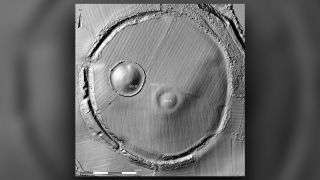
This lidar image shows the site at Navan Fort where the archaeologists did their survey work.
The remains of “monumental temples” dating to the Iron Age and medieval buildings may be hidden underground at Navan Fort, an archaeological site in Northern Ireland, a new study finds.
Exactly what’s left of these ruins, however, remains to be seen. Archaeologists discovered the buried structures by using remote-sensing techniques that allowed them to map the hidden landscape and detect anomalies, such as architectural features made by humans.
These Iron Age and medieval buildings suggest that Navan Fort was “an incredibly important religious center and a place of paramount sacral and cultural authority in later prehistory,” study co-researcher Patrick Gleeson, a senior lecturer of archaeology at Queen’s University Belfast in Northern Ireland, told Live Science.
Navan Fort, which sits just outside of Armagh city, was the capital of the ancient province of Ulster (known in Irish as Ulaid) in pre-Christian Ireland, according to medieval texts. It’s also the backdrop of various Irish myths and historical texts, which refer to it as “Emain Macha.”
Since the 1960s, archaeologists have recognized Navan Fort as a complex religious site that was used by the elite as long ago as the late Bronze Age and the Iron Age, or about 1000 B.C. to A.D. 100. More recently, historians have debated its role in later prehistoric and medieval Ireland. Now, the newly discovered Iron Age temples and medieval structures add support to the idea that Navan Fort was a key ceremonial site and also home to a developing kingship considered to be sacred.
The archaeologists spotted the structures with a mix of remote-sensing techniques: lidar (light detection and ranging), which uses millions of lasers shot from an overhead aircraft to map the ground; photogrammetry, which uses aerial photos to highlight depth and perspective on ground structures below; magnetic gradiometry, which can trace subtle magnetic changes in the soil; and electrical resistance, which measures electrical patterns in the soil.
Image 1 of 5Image 2 of 5Image 3 of 5Image 4 of 5Image 5 of 5Figure-of-eights
This isn’t the first archaeological look at Navan Fort. Excavations in the 1960s and 1990s revealed a “spectacular series of buildings” from the early Iron Age that “included a series of what’s called figure-of-eight buildings, as well as the largest building ever excavated in prehistoric Ireland that’s known as the 40-meter [130 feet] structure,” Gleeson said. After building the 40-meter structure with timber in about 95 B.C., ancient people filled it with stones and burnt it to the ground that same year, which created a huge mound that is still visible today.
Over the years, scholars have debated whether this series of buildings served a residential or religious purpose, Gleeson said. Medieval sources noted that the ancient Kings of Ulster (who ruled from about the fifth to 13th centuries A.D.) lived there, which would make it a residential space. But Gleeson and his colleagues at the University of Aberdeen in Scotland and the German Archaeological Institute, Frankfurt found that two, previously-known pairs of figure-of-eight buildings — named for the “8” shape — are part of a much larger site.
“The discoveries that we’ve made suggest that those buildings that were excavated are only a small part of much, much larger, much bigger, more impressive complexes,” Gleeson said.
The “tops” of these figure-of-eight buildings are about 82 feet (25 m) in diameter and the “bottoms” are smaller, at about 33 feet (10 m) in diameter, Gleenson said. Each of these buildings are located within an even larger, circular enclosure about 460 feet (140 m) in diameter. “Both of those enclosures intersect to form another figure-of-eight,” Gleeson said. “We have a three-fold figure-of-eight, really.”
Put another way, “we have two figure-of-eight shaped buildings in a much larger figure-of-eight shaped enclosure and all of that is contained within a series of palisades [wooden staked] enclosures of about 240 meters [787 feet] in diameter,” Gleeson said. “It’s a huge complex.”
These huge temples are among the largest and most complex ritual structures dating to later prehistory and pre-Roman times in Northern Europe, Gleeson said in a statement. He added that the repetitive use of the figure-of-eight motif may have cosmic significance, which suggests that “these are, in fact, religious structures.”
RELATED CONTENT
—Photos: Searching for Ireland’s 17th-century ‘pirate alliance’
—Emerald Isle: A photo tour of Ireland
—In photos: Intricately carved stone balls puzzle archaeologists
Of note, the four palisades predate the Iron Age 40-meter structure. It appears that Iron Age people built, destroyed and reconstructed temples repeatedly over generations on the same site, Gleeson told Live Science.
Human activity continued at Navan Fort after these Iron Age constructions, Gleeson and his colleagues found. The team team identified another complex of enclosures that likely date to early medieval times, a time when the Kings of Ulster are said to have lived there, Gleeson said.
It’s possible that Navan Fort was selected as a medieval royal residence because of the religious temples that had once stood here, Gleeson said. “Previously, it had been thought that it was a royal residence in prehistory and didn’t really have that cult element. So, this is really changing the way we look at Navan Fort.”
Next, once they secure funding, the team hopes to excavate these structures at Navan Fort, Gleeson said. Until then, archaeologists can only guess as to what purpose those medieval structures served. It’s possible that these buildings were domestic settlements, a church or even “the house recorded as being built at Emain Macha by Níall Óg Ua Neill for the learned poets of Ireland in the Annals of Ulster under 1387,” the researchers wrote in the study, which was published online July 16 in the Oxford Journal of Archaeology.
Sourse: www.livescience.com





